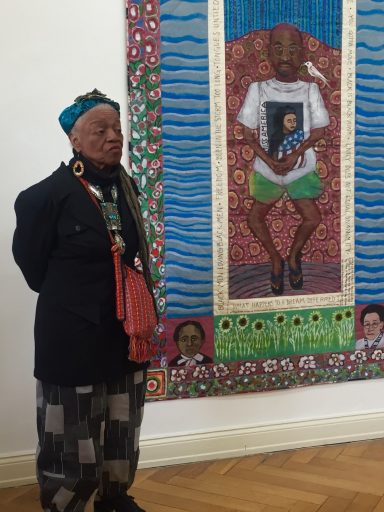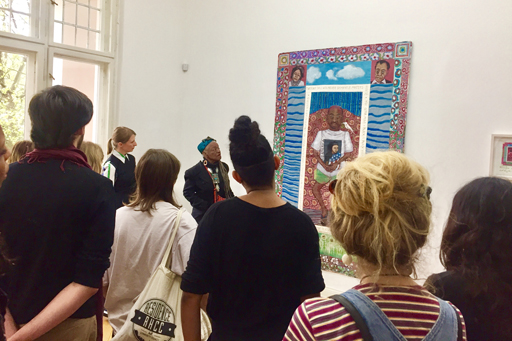The solo exhibition of the highly acclaimed interdisciplinary artist, activist, and writer, Faith Ringgold, opened at the Weiss Gallery in Berlin on April 24th, 2018. The exhibition opening was preceded by a brief talk with Ringgold and a number of students from two Bard College Berlin courses: Imagined Geographies, taught by Heba Amin and Migration, Gender, and Nationalism, led by Agata Lisiak.
The exhibition showcases Ringgold’s wide-ranging talent. On view until mid-June are a number of works across a variety of media, including story-quilts, soft sculpture, text and graphic work, acrylic, gouache, and ink paintings. Throughout the decades, Ringgold has applied a collagist approach to art-making, assembling paintings, texts, and patterns in her work to articulate black American narratives. Ringgold’s passion for storytelling is palpable in her work and her words. She structured our conversation prior to the exhibition opening casually, requesting that students ask her questions about her work. She then responded to all questions poetically, engaging us with dazzling memories from her childhood about her neighbors and famous Jazz musicians during the peak of the Harlem Renaissance; she described the significance of the imagery of the George Washington Bridge in her works — how it embodied youth and sweaty summer nights on rooftops far above the Hudson River.

We began by discussing Ringgold’s story-quilt entitled Marlon Riggs: Tongues Untied (1994). The work memorializes Marlon Troy Riggs, a black, queer American filmmaker, professor, poet, and gay-rights activist who died from AIDS on April 5th, 1994. An acrylic portrait of Marlon Riggs is positioned in the center rectangle of the story-quilt and is framed by quotes from famous black artists and thinkers. Smaller portraits of four highly influential black scholars, including James Baldwin and Audre Lorde, hover above and below the painting of Riggs. The powerful texts by Audre Lorde, James Baldwin, and Langston Hughes alongside the smaller portraits of these scholars function as a protective barrier in this work, symbolically shielding Riggs’ floating body from the realities of anti-blackness and homophobia in the United States. The finished work, a collage of text, image and pattern displayed on a quilt, is the product of a meticulous, multi-step working process.
Faith Ringgold draws her inspiration from her surroundings, her family lineage and history, texts she’s read, and media she’s absorbed. Beginning with a small sketch on paper, she develops multiple renditions of her original idea. She mentioned during our conversation that she sees writing on her work as a means of expressing herself “visually and orally,” thus using her work as a platform to define her own identity rather than allowing her race to dictate how she is perceived by society. Articulating this agency, she states: “I don’t believe in giving up my freedom of speech because someone thinks they can tell what I am by what I look like.”
Ringgold’s expressionist, narrative storyquilts reflect a long history of female collage work. Within her essay “Femmage,” artist and feminist art pioneer Miriam Schapiro discusses the importance of collage as a feminist artistic practice, suggesting that the aesthetic components of collage, such as assemblage, extraction, fragmentation, and use of text, reflect a strong “women’s culture” born out of a history of female domestic and nurturing responsibilities. She interprets this to be a history of “craft-making,” emblematic of a collective female creative consciousness [*1]. However, in making these claims, Schapiro essentializes the female experience and overlooks the intersectional approach to identity that would consider race, gender, age, and access as factors that affect such a consciousness. Ringgold’s collage work must not be simplified to an assemblage of a fragmented, universal female experience.
Through careful selection and presentation of certain narratives, texts, and bodies, Ringgold urges us to consider a, black, womanist artistic expression: “a heritage of art activities that shares many of the female characteristics of fragmentation and piecing together, but a heritage that must be comprehended in its own, quite different (black American) cultural context.” [*2] This womanist tradition is present in Ringgold’s use of textiles and fabric. Such work recalls the histories of enslaved Black female quilt makers who utilized the craft of quilt-making as a mode of survival and as a way to claim collective agency. In an age of brutal social control, enslaved Black women developed creative escapes from the horrors of enslavement: “frolics,” organized quilting parties, functioned as psychological departures from the institution of slavery, hidden under the guise of production, domesticity, and compliance.
Ringgold’s assemblage of fabric and textiles can thus be understood as a way of anchoring the black female body to a lineage of political resistance. Repurposing collage and craft-work within master works, Ringgold situates a traditionally “low-brow” means of artistic expression within the “high-brow” contemporary arts world and, in doing so, not only elevates contemporary narratives of black American socio-political resistance and cultural expression, but also recognizes the histories of enslaved black Americans who were forced to repurpose domestic labor as a mode of creative and cultural survival.
Today, as conservatism and neo-fascism dominate the political climate, Ringgold’s work is more urgent than ever. Her work is a call to action reminding bystanders of the power of creative practice as a method for social change. The exhibition will be open at Weiss Berlin until June 16th.
___________
Notes:
[*1] Schapiro, Miriam, and Melissa Meyer. “What Women Saved and Assembled FEMMAGE.” Editorial. Heresies, 1977.
[*2] RAABERG, GWEN. “Beyond Fragmentation: Collage as Feminist Strategy in the Arts.” Mosaic: An Interdisciplinary Critical Journal 31, no. 3 (1998): 153-71.

